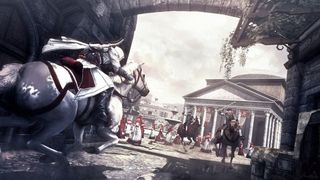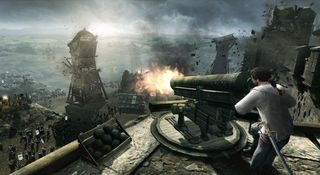Multiplayer assassination required some story justification, and the answering of crucial questions. Such as, how does it make sense in the context of the game's meta-story, where you are actually experiencing genetic memories in a machine called the Animus? “We came up with a pretty neat justification of it all,” explains Desilets. “Instead of this single engaging adventure, where you go into a machine and you're living the life of an ancestor, this time it's more like a simulation, based on individual memories of the ancestor. The reason you can kill and go back is because [it's a] training simulation of the Templars.” This multiplayer angle will open up new details of the war between the Templars and the Assassins, ensuring the story stays consistent, and is even fleshed out further for those wanting yet more understanding of this complicated and long-lasting feud.
You start as a recruit, working your way to becoming a fully-fledged assassin on the streets of Florence, San Donato or Rome. The Wanted mode casts you as both predator and prey. You're given a target that you have to identify and take down. Simple enough? Not quite. Your target may be a priest, but there are a lot of priests wandering around the portions of Rome specifically built for the multiplayer game. So identifying your actual target becomes about recognising player traits and movement styles.
“A player is more inclined to run than an NPC or AI,” Desilets explains. “And players will be the only ones going on rooftops. You have to locate him by looking around and watching their behaviour.”

Now add another wrinkle: you are another assassin's target. While you're stalking, you're being stalked. A warning will flash to let you know if the assassin is on your tail, and then it's time to flee. Each kill and each escape earns you points, with the winner being the assassin with the most points, rather than just the most kills.
It's not just who you kill (you lose points for culling innocent civilians), but how you do it that earns the bigger points. Techniques with such names as Unspotted, Escape, Focus, Silent and Hidden Kill all encourage you to get creative. Sure, you can kill any other player you see running through the streets, but you don't get as many points for that. Besides which, such overtly aggressive behaviour is as good as waving around a big “Assassinate me” sign.
Clambering across the rooftops, then descending silently on their target, is the way experienced players of the singleplayer game will play it. But the Wanted mode plays out at a pace that shouldn't terrify newcomers, either. It's not so much about twitch as it is about observation. There's a rare thrill to getting a warning that an assassin is on your tail, blending yourself in among a group of similarly attired NPCs, then darting to escape when the coast is clear. Similarly, the excitement of leaping across buildings to close on your target, then catching him in your sights and delivering a silent, fatal blow is uniquely rewarding.

According to Stephane Baudet, creative director behind the multiplayer mode, “The multiplayer maps are Abstergo's interpretation of historical locations for the purpose of training.” Abstergo Industries being the obligatory Sinister Corporation of the Assassin's Creed universe. So there's an in-story context for why these maps differ from the size and layout of those seen in the singleplayer game.
PC Gamer Newsletter
Sign up to get the best content of the week, and great gaming deals, as picked by the editors.
Each location is also designed to make possible fast-paced, free-running chases, with items and locations built into the environment to enhance the thrill of the hunt. Baudet revealed that beams, corner swings and other devices will be designed to break after being used, giving an edge to the player trying to escape.
All of the points you accumulate in multiplayer can then be spent customising your avatar, picking special skills such as speed boosts and higher jumps. The points you acquire will also allow you to open up new WANTED MODE Brotherhood's chain of death modes and maps. The multiplayer avatars themselves are based on historically accurate character types, such as the priest, noble, executioner, prowler, doctor and courtesan. But while you might see many executioners in the streets, identifying your actual target can also require the use of additional skills. When you're being pursued, you can toss a smoke bomb or disguise yourself in another target's skin – you'll even be able to dress unwitting NPC s in your skin to throw aggressors off your tail.

It played remarkably well. The interface pops up warnings when you're in danger, blending intriguing stealth mechanics into the flurry of combat. The city maps are the perfect playground for the game style, and while it might seem odd when five identical courtesans are standing on a street corner, you have to be aware of each move they make, as one of them could be your prey – or your predator.
In multiplayer alone it's clear that Brotherhood is a significant addition to the Assassin's Creed world. But in Rome, it now has a fabulous new location to explore, at a time when that city was still catching up with the more progressive cities of Florence and Venice. The detail level in the buildings and characters, even the voice recording (Nolan North and Roger Craig Smith reprising their roles as Desmond and Ezio, respectively) are all top-notch. High production values have always been an AC hallmark, and Brotherhood lives up to that standard.
“We're still continuing Desmond's story in the present, and we're continuing all the weird puzzles,” Desilets says, and he promises more 'linear sequences' that will progress the story of Abstergo Industries, the Animus, and the characters we're getting to know so well. The addition of a unique multiplayer component, on top of all this, makes Brotherhood an enticing prospect for newcomers and established assassins alike.
- Release: 16 November 2010
- Publisher: Ubisoft
- Developer: In-house
- Link
Rob Smith
Hey folks, beloved mascot Coconut Monkey here representing the collective PC Gamer editorial team, who worked together to write this article! PC Gamer is the global authority on PC games—starting in 1993 with the magazine, and then in 2010 with this website you're currently reading. We have writers across the US, UK and Australia, who you can read about here.
Most Popular


